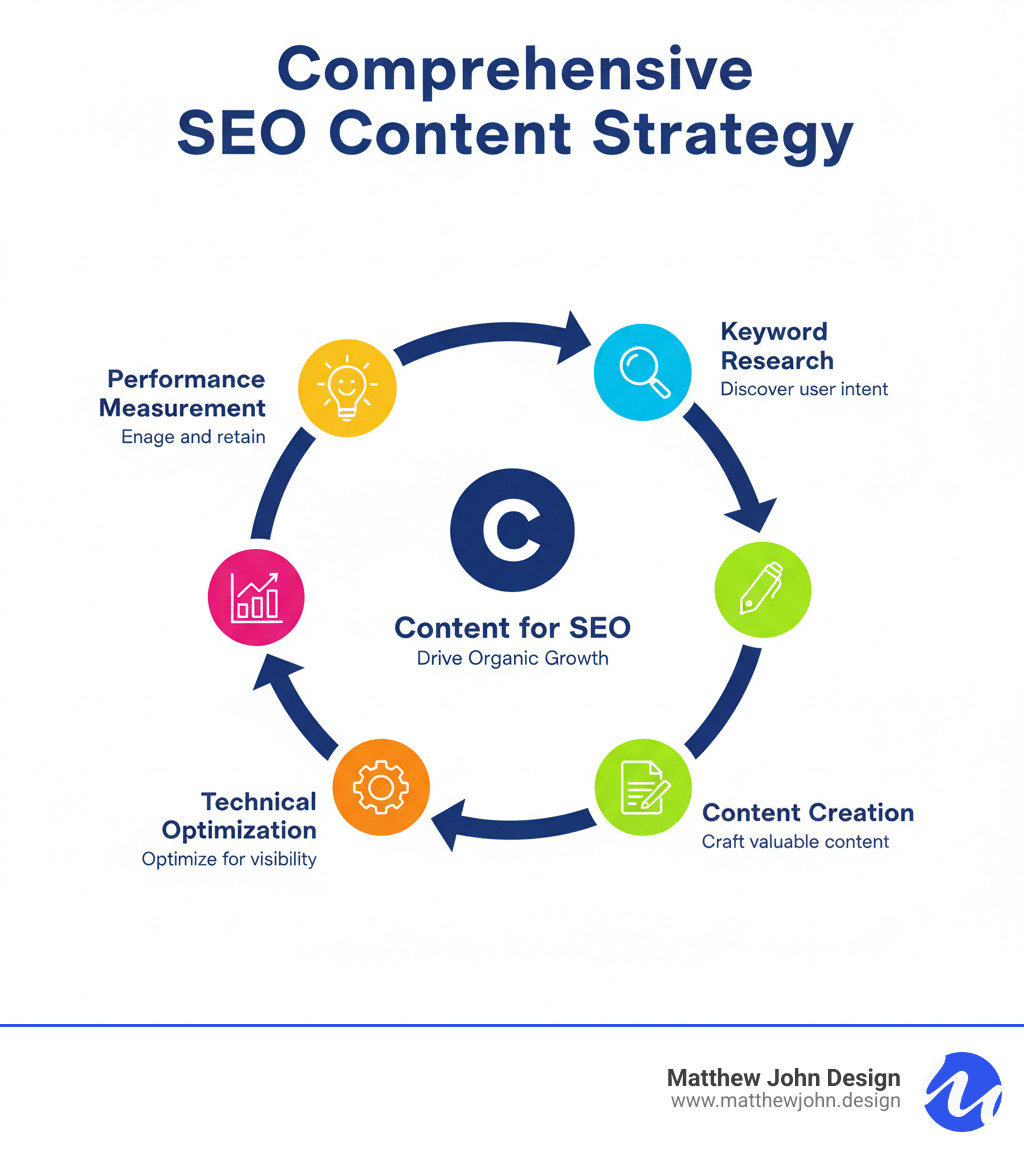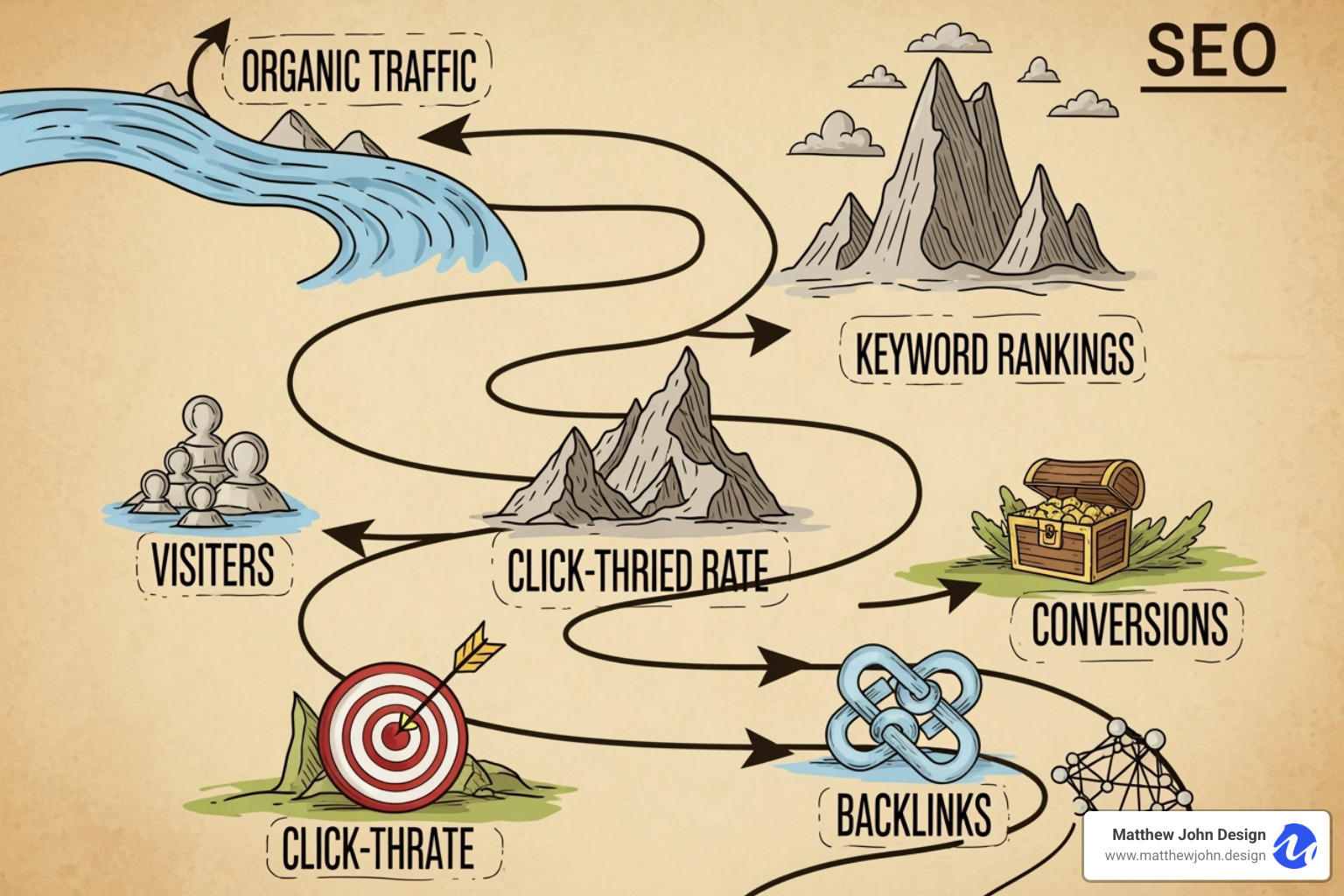Any information contained on this Website is not legal advice and should not be treated as such. You should always contact an attorney for help with your specific legal needs and issues. We may also earn a commission when you click links to our partners and purchase goods or services. For more information, read our Disclaimers Policy.
Why Content for SEO Drives Digital Success
Content for SEO is the practice of creating valuable, search-optimized material that ranks well in search engines while genuinely serving your audience's needs. It combines strategic keyword research, user intent matching, and technical optimization to help your content get found, engaged with, and shared.
Quick Answer: Essential Elements of Content for SEO
- Keyword Research: Target terms your audience actually searches for
- Search Intent Matching: Create content that answers user queries completely
- Quality & Uniqueness: Provide original insights and comprehensive coverage
- Technical Optimization: Optimize titles, meta descriptions, headers, and URLs
- User Experience: Ensure fast loading, mobile-friendly, readable content
- Authority Building: Earn backlinks through valuable, shareable content
As one research source notes: "When the majority of users never venture beyond the first page of search results, simply creating content is no longer enough." Your content strategy must work harder than ever.
Google's algorithms prioritize content that demonstrates expertise and matches user intent precisely, making keyword stuffing and thin content obsolete. With competitors investing heavily in content marketing, a strategic approach is essential to avoid being invisible to your ideal customers.
Effective content for SEO isn't about gaming the system; it's about creating genuinely helpful content that search engines want to rank. By aligning quality content with smart SEO, you build sustainable organic growth.
This guide will show you how to create content that serves both your audience and search engines, covering the strategic framework, technical essentials, and measurement practices that separate winning content from digital noise.

The Blueprint: Strategizing for SEO Success

Creating content for SEO requires a strategic blueprint. A successful campaign begins with understanding what your audience needs and how search engines will find your work. Investing time in keyword research, audience analysis, and site structure builds the foundation for long-term organic growth.
Mastering Keyword Research & Search Intent
Great content for SEO starts with the words your audience uses. Effective keyword research balances search volume with keyword difficulty to find terms with decent traffic and manageable competition. Tools like Semrush's Keyword Magic Tool can help identify these opportunities.
Beyond keywords, search intent analysis is crucial. You must match your content to the user's goal. The four main types of search intent are:
- Informational: Seeking answers (e.g., "how to optimize images").
- Navigational: Looking for a specific site.
- Commercial Investigation: Researching before a purchase (e.g., "best website builders").
- Transactional: Ready to buy or act.
Analyze the current search results for your target keywords to understand what type of content Google favors. Long-tail keywords (e.g., "SEO content strategy for small businesses") are also valuable, as they often have clearer intent and less competition, attracting more qualified visitors.
Understanding Your Audience & E-E-A-T
Content resonates when you deeply understand your audience. Buyer personas are roadmaps to creating content that speaks to real people. Identify their pain points, goals, and language using surveys (Google Forms, Typeform) or audience intelligence tools (Sparktoro).
Google's E-E-A-T guidelines (Experience, Expertise, Authoritativeness, Trustworthiness) are vital, especially for Your Money or Your Life (YMYL) topics. You must demonstrate credibility by:
- Experience: Showing you've used the products/services.
- Expertise: Providing detailed, accurate information.
- Authoritativeness: Being a recognized source.
- Trustworthiness: Ensuring accuracy and transparency.
For many topics, sharing first-person insights and real examples from your work is enough to demonstrate valuable "everyday expertise." Weave your experience into your content by sharing how you've applied concepts and what you've learned.
Structuring Your Kingdom: The Hub-and-Spoke Model
Smart site architecture makes your content more findable. The hub-and-spoke model (or topic cluster strategy) is highly effective.
Pillar pages are comprehensive guides on broad topics. Topic clusters are more specific articles that branch off from the pillar, linking back to it and to each other. This creates a web of related content that signals authority to search engines.
Cornerstone content is your most important pillar content, optimized for your most valuable keywords. Strategic internal linking ties it all together, passing authority to your most important pages and preventing keyword cannibalization (where multiple pages compete for the same term).
This structure works well with Webflow's flexible CMS, allowing you to build content relationships that boost your entire site's authority and performance.
Crafting High-Impact Content for SEO

Creating high-impact content for SEO requires skill and patience. The best content combines strategic optimization with authentic value, helping people solve problems while satisfying search engine criteria.
Writing Compelling and Readable Content
Content that reads like it was written for robots will fail. Search engines reward content that serves people well. Audience-first copywriting means speaking your customer's language and matching your content's depth to their needs.
Originality is key; your unique perspective and experience make your content worth reading. Share real wins, mistakes, and insights from your work.
Readability is also critical. Use short sentences, active voice, and ample white space. Break up long paragraphs into digestible chunks. Tools like Hemingway and Grammarly can help improve clarity. Clear H2 and H3 subheadings act as signposts, improving user experience and helping you earn featured snippets.
While word count isn't a goal, comprehensiveness is. The best content for SEO thoroughly answers a user's query, covering all necessary steps and resources.
Achieving Uniqueness and Information Gain
To stand out, you must provide new value. Google's concept of "information gain" rewards content that adds something new to the conversation. You can achieve this through:
- Expert opinions and personal experience: Sharing first-hand knowledge builds trust and demonstrates expertise.
- Proprietary data: Publishing unique data from surveys, analytics, or case studies creates linkable assets.
- Covering new subtopics: Address angles or details that other guides have missed.
- Original research: Even small experiments can generate highly shareable content and earn quality backlinks.
Mastering On-Page Elements for your content for SEO
On-page optimization frames your content for search engines.
- Title Tags: Your first impression in search results. Keep them under 60 characters, include your target keyword, and make them compelling.
- Meta Descriptions: These snippets (under 160 characters) are your sales pitch to earn the click. They don't directly impact rankings but are crucial for click-through rates.
- Header Tags: Your H1 should state the page's topic and include the primary keyword. H2s and H3s structure the content and can target related keywords.
- Natural Keyword Integration: Weave keywords into your content conversationally. Avoid keyword stuffing, which violates Google's spam policies and harms readability.
- URL Optimization: Use short, descriptive URLs with hyphens and relevant keywords.
The Technical Crown: Optimizing for Search Engines

Great content for SEO needs a strong technical foundation to perform. Even brilliant content can fail if technical details like site speed and mobile-friendliness are ignored.
Optimizing Multimedia: Images and Video
Images and videos need optimization to support SEO. For images, use descriptive file names (webflow-seo-guide.jpg instead of IMG_1234.jpg), compress files for faster loading, and write helpful alt text. This descriptive text aids accessibility and tells search engines what an image shows.
For video, optimize titles and descriptions with relevant keywords and provide transcripts. Transcripts make videos accessible and give search engines crawlable text.
Crucially for Webflow users: Webflow only supports background videos up to 30 MB and does not provide native video hosting for larger files. For larger videos, use third-party hosting solutions like YouTube, Vimeo, or Vidzflow. Learn more about our SEO Writing and Video services.
Enhancing User Experience and Technical Signals
Google's page experience signals are essential for rankings. This includes:
- Mobile-First Indexing: Google prioritizes mobile-friendly websites, so your site must be fully responsive.
- Core Web Vitals: These metrics measure loading speed, interactivity, and visual stability, directly impacting user satisfaction and rankings.
- Site Speed: Fast loading times are critical for user experience and conversions.
- XML Sitemaps: An XML sitemap acts as a roadmap, helping search engines efficiently crawl and index your important pages.
- Schema Markup: This structured data helps search engines understand your content's context, increasing your chances of earning rich snippets. Use tools like Merkle's Schema Markup Generator to implement it.
Explore How Semantic SEO Impacts the Content Creation Process for more details.
Building Authority with Strategic Link Building
Backlinks should be a natural result of creating exceptional content for SEO. As an expert notes, "High quality content...sparks conversations and helps you become a reference point in your industry."
Earn quality backlinks by:
- Creating shareable content: Provide genuine value that other sites will want to reference.
- Relationship building and digital PR: Become a trusted resource in your industry. Successful digital PR builds authority and earns links.
- Guest posting: Write for high-quality, relevant websites to reach new audiences and gain backlinks.
- Strategic internal linking: Linking to other articles on your own site distributes authority and keeps users engaged.
Our SEO Content Links service focuses on this value-driven approach.
Measuring Success and Reigning Long-Term

Successful content for SEO requires continuous monitoring, analysis, and adaptation. Performance data is a treasure map that reveals how your audience interacts with your content, highlighting opportunities for improvement.
Tracking Performance with Key SEO Metrics
Digital marketing is measurable. Track your content for SEO with these key metrics, using tools like Google Search Console and Google Analytics:
- Organic Traffic: The number of visitors from search engines. Consistent growth signals a successful strategy.
- Keyword Rankings: Your content's position in search results for target terms. Track progress with tools like Semrush's Position Tracking.
- Click-Through Rate (CTR): The percentage of people who click your result after seeing it. Low CTR may indicate a need for better titles or meta descriptions.
- Bounce Rate & Dwell Time: These engagement metrics show if visitors stick around. High engagement signals value to Google.
- Conversion Rate: The percentage of visitors who complete a desired action (e.g., signup, purchase). This connects content to business results.
- Backlink Growth: The number of new links from other websites, a measure of authority. Monitor this with tools like Semrush's Backlink Analytics.
Adapting and Refreshing Your Content for SEO
Content performance naturally decays over time. Content for SEO requires ongoing care to stay relevant and competitive.
Even evergreen content needs periodic updates. Our content refresh process is systematic: we update facts and statistics, expand comprehensiveness with new insights, and improve readability. We also optimize for new keywords as search trends evolve.
These data-driven decisions are guided by performance analytics. For example, high impressions but low CTR means we should refine the title and meta description.
We leverage AI in our AI Driven SEO Content Creation process for tasks like idea generation and research, but human expertise always ensures quality, accuracy, and brand voice. Learn more about our approach with AI Tools for SEO Content Creation.
Treating content as a living asset that you continuously improve is the key to building a long-term competitive advantage.
Frequently Asked Questions about Content for SEO
What is the ideal length for SEO content?
There is no magic word count. The ideal length for content for SEO depends on the topic and search intent. While research shows comprehensive content (often 1,400+ words) tends to rank well, this is because it thoroughly answers user questions.
For example, "how to change a tire" might need a 500-word guide, while a "complete guide to car maintenance" could be over 3,000 words. Focus on being exhaustive and matching the user's needs, not on hitting an arbitrary word count. The right length is the one that completely satisfies the query.
How often should I publish new content for SEO?
Consistency beats frequency. Publishing one high-quality, valuable article per week is far better than churning out mediocre content daily. Google values quality and relevance above all else. A single outstanding piece of content for SEO will outperform dozens of shallow articles.
Create a realistic content calendar that allows you to maintain high standards. The right frequency is whatever allows you to consistently deliver value. Regular publishing builds an audience and signals to search engines that your site is active and authoritative.
Can I do SEO content myself?
Yes, you can create effective content for SEO yourself with the right knowledge and tools. However, success requires ongoing learning and effort, as SEO is not a set-it-and-forget-it activity.
The real question is whether it's the best use of your time. For simple sites in less competitive niches, DIY can work well. But for complex websites or highly competitive industries, partnering with professionals can accelerate results significantly. If you find yourself spending more time on SEO than on your core business, it may be time to seek expert help.
Conclusion
Creating dominant content for SEO is a craft that blends strategy, creativity, and technical skill. It's about building a digital asset that serves both your audience and search engines.
The process begins with deeply understanding your audience and their search intent. From there, you craft unique, insightful content supported by a strong technical foundation. Finally, long-term success requires continuous measurement, adaptation, and improvement.
What sets winning content for SEO apart is the seamless integration of audience research, quality writing, technical optimization, and performance tracking. By making SEO an integral part of your content process, you ensure your message reaches the people who need it most. This comprehensive approach transforms content from invisible to influential.
At Matthew John Design, we specialize in building the digital platforms and content strategies that make this possible. Our Webflow sites provide the perfect foundation for SEO-optimized content, and our strategic approach ensures every piece works harder for your business.
Ready to lift your content from overlooked to outstanding? Explore our SEO Writing and Video services and find how we can help your content reign supreme in search results.

.jpg)